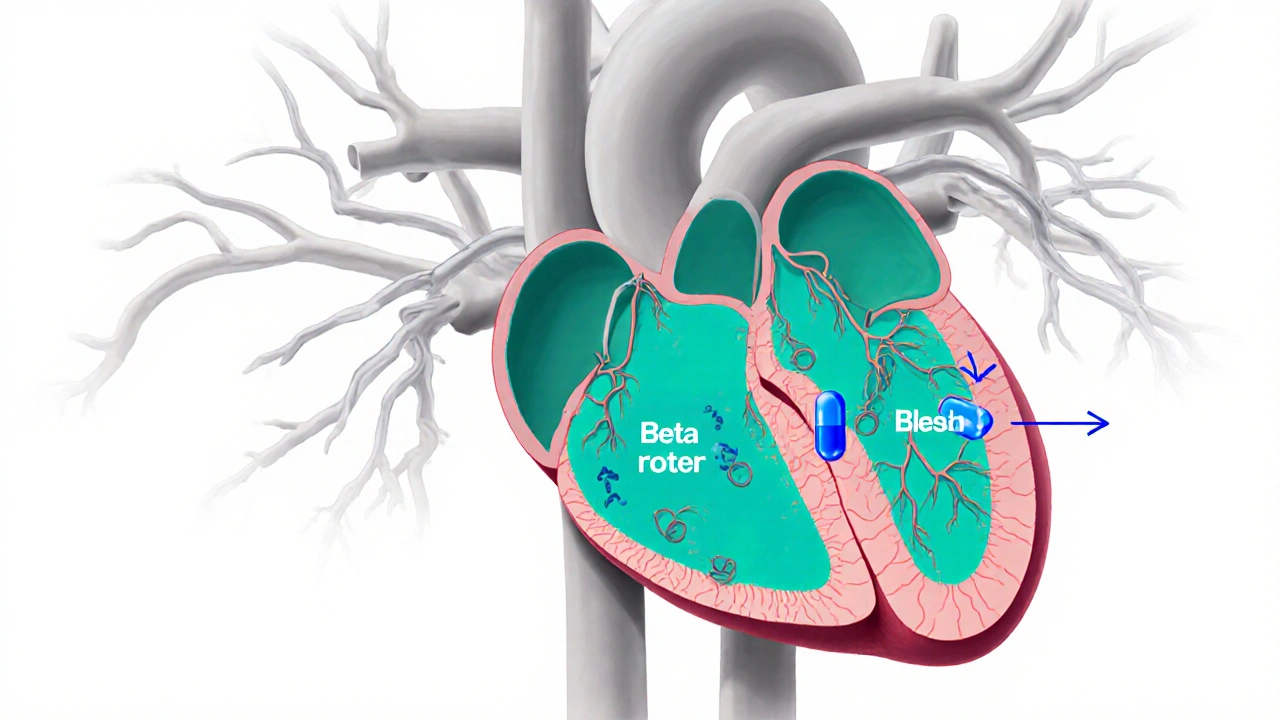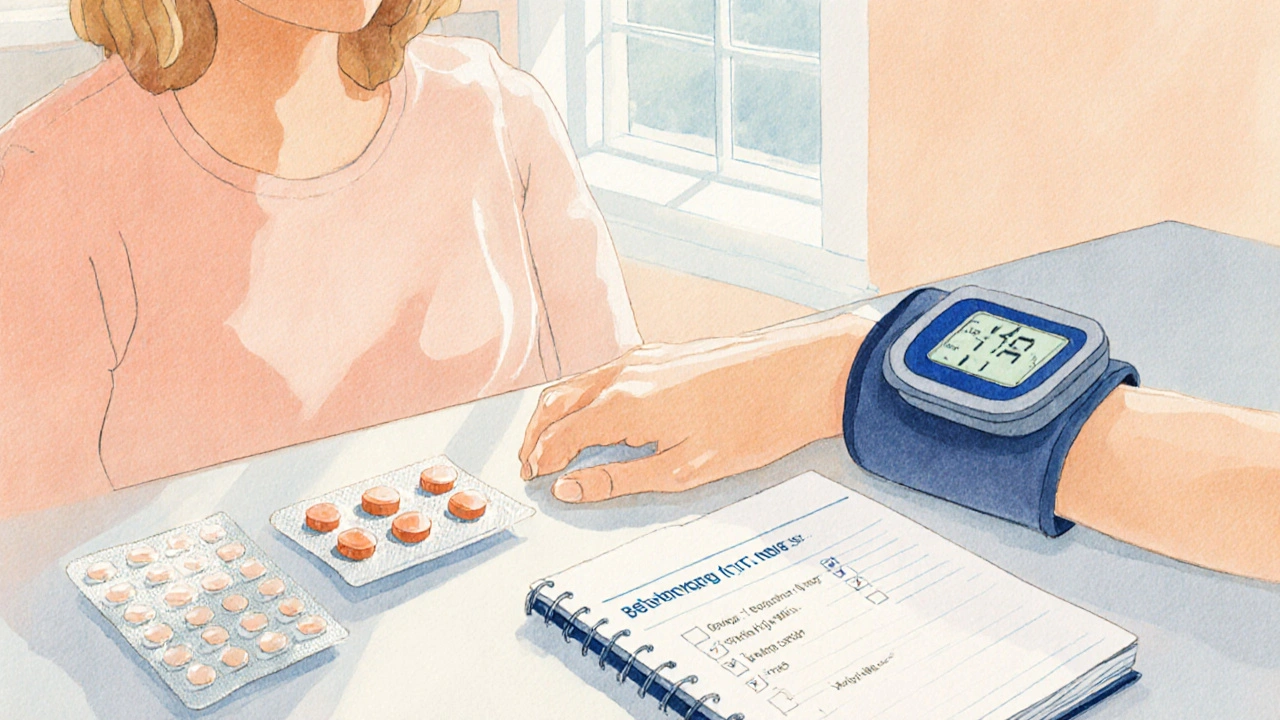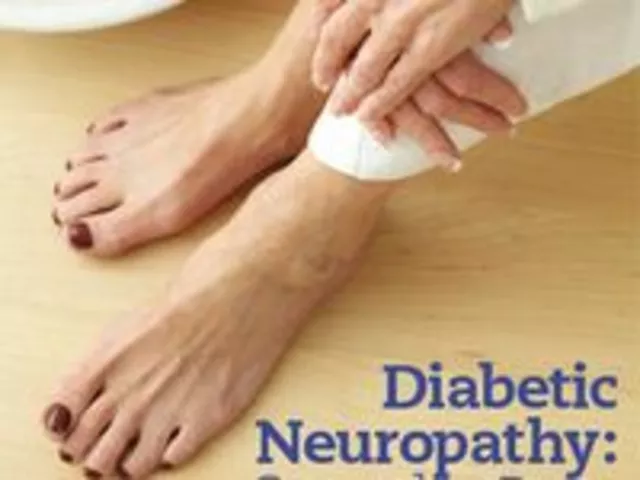Beta-Blocker Effectiveness Calculator
Effectiveness Results
Expected Benefits
Potential Side Effects
Chest pain that comes on during activity or stress can feel scary, especially when you don’t know why it happens. In many cases that pain is a sign of angina - a warning that the heart isn’t getting enough oxygen. One of the oldest and most trusted ways to calm that warning is by using beta-blockers. This article walks you through what angina is, how beta‑blockers help, when doctors prescribe them, and what you should watch out for while taking them.
Key Takeaways
- Beta‑blockers lower heart rate and blood pressure, reducing the heart’s oxygen demand.
- They are first‑line therapy for chronic stable angina and secondary prevention after a heart attack.
- Common side effects include fatigue, cold extremities, and sleep disturbances; most are manageable.
- Patients should combine beta‑blockers with lifestyle changes and, when needed, fast‑acting nitroglycerin.
- Regular follow‑up is essential to adjust dosage and monitor heart function.
What is Angina?
Angina is a symptom of chest pain or discomfort caused by reduced blood flow to the heart muscle. The pain typically feels like pressure, squeezing, or heaviness and appears during physical exertion or emotional stress when the heart works harder. Angina is usually a sign of underlying myocardial ischemia - the condition where heart tissue receives less oxygen than it needs.

How Beta‑Blockers Work
Beta‑blocker is a class of medication that blocks the effects of adrenaline on beta‑adrenergic receptors in the heart. By doing so, they slow the heart rate and lower blood pressure. A slower, less forceful heartbeat means the heart muscle uses less oxygen, which directly tackles the root cause of angina.
Beta‑blockers also improve the heart’s efficiency during rest, making it more tolerant of brief periods of reduced blood flow. Over time, this reduces the frequency and severity of angina attacks.
When Are Beta‑Blockers Prescribed for Angina?
Guidelines from major cardiology societies (e.g., ESC 2023, ACC/AHA 2022) place beta‑blockers as the first‑line oral therapy for chronic stable angina. Doctors typically start a patient on a low dose and increase it based on symptom relief and tolerability. They are also a mainstay for secondary prevention after a myocardial infarction, because keeping the heart’s workload low reduces the risk of another event.
Typical scenarios include:
- Persistent angina despite lifestyle changes.
- Patients who have survived a heart attack and need long‑term protection.
- Individuals with concurrent hypertension or certain arrhythmias, where beta‑blockers provide dual benefits.
Benefits and Risks of Beta‑Blockers
**Benefits**
- Reduced oxygen demand: Lower heart rate means the heart works less hard.
- Decreased frequency of angina episodes, often by 30‑50% within weeks.
- Lower risk of future heart attacks and cardiovascular mortality, with studies showing up to a 20% mortality reduction in high‑risk patients.
- Additional control of high blood pressure and certain rhythm disorders.
**Common Side Effects**
- Fatigue or feeling unusually weak, especially when first starting.
- Cold hands and feet due to reduced peripheral circulation.
- Sleep disturbances or vivid dreams.
- Mild depression in susceptible individuals (rare).
**When to Seek Help**
- Sudden worsening of chest pain that doesn’t respond to nitroglycerin.
- Severe shortness of breath, dizziness, or fainting.
- Heart rate dropping below 50bpm without physician guidance.

Comparing Beta‑Blockers with Other Anti‑Anginal Medications
| Feature | Beta‑Blocker | Calcium Channel Blocker | Nitroglycerin (Short‑acting) |
|---|---|---|---|
| Primary Action | Reduces heart rate & blood pressure | Vasodilation of coronary arteries | Immediate vessel dilation |
| Onset of Relief | Hours to days (daily dosing) | Hours (once or twice daily) | Minutes (sublingual) |
| Best For | Chronic stable angina, post‑MI patients | Patients with asthma or bradycardia contraindications | Acute breakthrough chest pain |
| Common Side Effects | Fatigue, cold extremities, sleep issues | Swelling, flushing, headache | Headache, low blood pressure |
| Impact on Mortality | Reduces cardiovascular death (evidence‑based) | Neutral or modest benefit | No mortality benefit, only symptom relief |
Most clinicians start with a beta‑blocker unless the patient has asthma, severe chronic obstructive pulmonary disease, or a contraindicating low heart rate. In those cases, a calcium channel blocker may be preferred, often in combination with a short‑acting nitrate for immediate relief.
Practical Tips for Patients on Beta‑Blockers
Taking a medication correctly can make the difference between a smooth recovery and a frustrating flare‑up. Here’s a quick checklist to keep you on track:
- Start low, go slow: Follow the prescribing doctor’s titration schedule. Missed doses can cause rebound tachycardia.
- Monitor your pulse: Aim for a resting heart rate between 50-60bpm unless advised otherwise.
- Watch your blood pressure: Readings should stay within your target range (often <130/80mmHg for cardiac patients).
- Stay active, but pace yourself: Light aerobic exercise improves heart efficiency; avoid high‑intensity bursts that trigger angina.
- Combine with fast‑acting nitroglycerin: Keep sub‑lingual tablets handy for sudden chest pain.
- Discuss other meds: Some over‑the‑counter cold remedies, decongestants, or thyroid meds can interfere with beta‑blockers.
- Regular follow‑up: Schedule ECGs and blood tests every 3-6 months to assess heart function and electrolyte balance.
Also, integrate lifestyle modification is a set of diet, exercise, and stress‑reduction strategies that complement medication. Cutting saturated fats, quitting smoking, and managing stress have been shown to reduce angina episodes by up to 25% when paired with medication.
Frequently Asked Questions
Can I stop beta‑blockers once my chest pain improves?
Never stop abruptly. Sudden withdrawal can cause a rebound increase in heart rate and trigger angina or even a heart attack. Always taper under a doctor’s guidance.
Are beta‑blockers safe for people with asthma?
Traditional non‑selective beta‑blockers (like propranolol) can worsen asthma. Cardio‑selective options (e.g., metoprolol, bisoprolol) are safer, but your doctor will weigh the risks before prescribing.
How long does it take to feel relief after starting a beta‑blocker?
Most patients notice a reduction in angina frequency within 1-2 weeks, though full dose optimisation may take up to 6 weeks.
Will beta‑blockers affect my ability to exercise?
Initially you may feel less stamina, but as your heart becomes more efficient, many patients can exercise at a higher intensity without triggering angina.
Is it okay to take over‑the‑counter painkillers with beta‑blockers?
Acetaminophen is generally safe. NSAIDs (like ibuprofen) can raise blood pressure and should be used cautiously, especially in patients with hypertension.
Beta‑blockers have been a cornerstone of angina management for decades, and when paired with modern lifestyle advice they remain one of the most effective ways to keep chest pain at bay and protect the heart for the long run.








Shaik Basha October 6, 2025
Yo, beta‑blockers are like a chill brake for your heart – they slow the beat so you don't run out of O2 when you're hustlin' or stressin'. They cut down the demand on the myocardium, which means less chest pain during a run or even a quick stair climb. Plus, they help keep that blood pressure in check, so the whole circulatory system stays smoother. Just remember to start low, and your doc will tweak the dose till you feel steady.
Michael Ieradi October 12, 2025
Beta blockers lower heart rate and blood pressure.
Stephanie Zuidervliet October 19, 2025
Wow!!! This stuff really does the trick!!
But honestly, the article could have cut the fluff and got straight to the point!!
People reading this want the quick rundown, not a textbook!!!
Still, the table comparison was kinda handy!!
Overall, solid info but could be snappier!!
Olivia Crowe October 25, 2025
Feeling hopeful! Beta‑blockers can really give you that steady heartbeat you need.
Stick with your doctor’s plan and you’ll see the difference.
Aayush Shastri October 31, 2025
In many Indian households we balance meds with a spicy diet and regular walks. Beta‑blockers work well when paired with low‑salt meals and gentle yoga. It’s respectful to monitor your pulse each morning, especially if you’re also managing diabetes. Keep your doctor in the loop about any traditional herbs you take.
Quinn S. November 6, 2025
While the article presents a satisfactory overview, it fails to emphasize the necessity of stringent dosage titration. The omission of contraindications, particularly in asthmatic patients, is a glaring oversight. Clinicians must demand rigorous monitoring of bradycardia risk. Moreover, the language should reflect the gravity of potential adverse events without colloquial dilution.
Dilip Parmanand November 12, 2025
Just start low, stay consistent, and you’ll notice fewer angina attacks fast.
Sarah Seddon November 19, 2025
Think of beta‑blockers as the backstage crew that keeps the heart’s performance smooth. They dim the spotlight on adrenaline, letting your heart play a calmer tune. When side‑effects pop up, a splash of bright optimism and a chat with your doc can turn the script around. Keep the rhythm, stay active, and let the medication do its quiet work.
Ari Kusumo Wibowo November 25, 2025
Listen, if you ignore the dosage guidelines you’re just asking for trouble. Beta‑blockers aren’t a joke; they’re a serious tool for heart management. Follow the plan, monitor your numbers, and quit the reckless excuses.
Hannah Gorman December 1, 2025
It is quite evident that the casual dismissal of methodological rigor in the preceding commentary undermines the broader clinical relevance of beta‑blockade in angina management. Firstly, the pharmacodynamic nuances of selective versus non‑selective agents merit a deeper exposition that the original piece glosses over. Secondly, while the author modestly mentions side‑effects, there is a conspicuous absence of discussion regarding the impact on metabolic rate and potential interference with glycemic control in diabetic cohorts. Thirdly, the interplay between beta‑blockers and concurrent nitrate therapy is not merely a footnote but a pivotal consideration for titration strategies. Fourthly, the omission of real‑world adherence data obscures the practical challenges clinicians face, especially in heterogeneous populations with varying socioeconomic backgrounds. Fifthly, a thorough risk‑benefit analysis must incorporate the emerging evidence on quality‑of‑life metrics, which the article neglects entirely. Sixthly, the simplistic presentation of dosage increments fails to acknowledge the physiological variability observed in geriatric patients, whose chronotropic response may be blunted. Seventhly, the article’s tabular comparison, while aesthetically pleasing, lacks a critical appraisal of study design biases inherent in the referenced trials. Eighthly, an exploration of alternative therapeutic pathways, such as ivabradine, would have provided a more balanced perspective. Ninthly, the cognitive load imposed by the myriad of potential drug‑drug interactions remains unaddressed, leaving clinicians without essential guidance. Tenthly, the narrative does not reflect the evolving guidelines that now emphasize shared decision‑making with patients. Eleventhly, the simplistic language used may inadvertently downplay the seriousness of bradyarrhythmias that can ensue. Twelfthly, there is a missed opportunity to discuss the role of beta‑blockers in secondary prevention beyond angina, particularly post‑myocardial infarction. Thirteenthly, integrating patient‑reported outcomes could have enriched the discussion considerably. Fourteenthly, the article refrains from critiquing the economic implications of long‑term beta‑blocker therapy. Finally, the overarching tone seems to prioritize convenience over comprehensive education, which could mislead readers seeking nuanced clinical guidance.
Dan Burbank December 7, 2025
One must not simply accept the prevailing clinical dogma without interrogating its epistemological foundations. The hegemony of beta‑blockade, while historically justified, now contends with an influx of novel agents reshaping therapeutic algorithms. A perspicacious appraisal mandates scrutiny of trial heterogeneity, as the aggregate effect sizes mask divergent subgroup responses. Moreover, the dialectic between pharmacological precision and patient‐centric pragmatism demands a re‑evaluation of monotherapy versus polypharmacy paradigms. In essence, the clinician’s intellectual rigor should parallel the complexity of cardiovascular pathophysiology.
Anna Marie December 14, 2025
I appreciate the scholarly tone yet would caution against overly esoteric language that may alienate practitioners seeking actionable guidance. While the philosophical depth is commendable, a concise summary of dosing recommendations and monitoring checkpoints would enhance utility. The avoidance of emoticons preserves professional decorum, aligning with the expectations of a clinical audience.